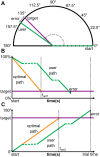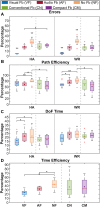A compact solution for vibrotactile proprioceptive feedback of wrist rotation and hand aperture
- PMID: 39135110
- PMCID: PMC11320866
- DOI: 10.1186/s12984-024-01420-y
A compact solution for vibrotactile proprioceptive feedback of wrist rotation and hand aperture
Abstract
Background: Closing the control loop between users and their prostheses by providing artificial sensory feedback is a fundamental step toward the full restoration of lost sensory-motor functions.
Methods: We propose a novel approach to provide artificial proprioceptive feedback about two degrees of freedom using a single array of 8 vibration motors (compact solution). The performance afforded by the novel method during an online closed-loop control task was compared to that achieved using the conventional approach, in which the same information was conveyed using two arrays of 8 and 4 vibromotors (one array per degree of freedom), respectively. The new method employed Gaussian interpolation to modulate the intensity profile across a single array of vibration motors (compact feedback) to convey wrist rotation and hand aperture by adjusting the mean and standard deviation of the Gaussian, respectively. Ten able-bodied participants and four transradial amputees performed a target achievement control test by utilizing pattern recognition with compact and conventional vibrotactile feedback to control the Hannes prosthetic hand (test conditions). A second group of ten able-bodied participants performed the same experiment in control conditions with visual and auditory feedback as well as no-feedback.
Results: Conventional and compact approaches resulted in similar positioning accuracy, time and path efficiency, and total trial time. The comparison with control condition revealed that vibrational feedback was intuitive and useful, but also underlined the power of incidental feedback sources. Notably, amputee participants achieved similar performance to that of able-bodied participants.
Conclusions: The study therefore shows that the novel feedback strategy conveys useful information about prosthesis movements while reducing the number of motors without compromising performance. This is an important step toward the full integration of such an interface into a prosthesis socket for clinical use.
Keywords: Closed-loop control; Gaussian interpolation; Hannes hand; Multichannel stimulation; Proprioceptive feedback; Spatial encoding; Vibromotors.
© 2024. The Author(s).
Conflict of interest statement
SD is an Associate Editor of the Journal of NeuroEngineering and Rehabilitation.
Figures






Similar articles
-
A Novel Method for Vibrotactile Proprioceptive Feedback Using Spatial Encoding and Gaussian Interpolation.IEEE Trans Biomed Eng. 2023 Dec;70(12):3354-3365. doi: 10.1109/TBME.2023.3285850. Epub 2023 Nov 21. IEEE Trans Biomed Eng. 2023. PMID: 37314906
-
Restoration of motor control and proprioceptive and cutaneous sensation in humans with prior upper-limb amputation via multiple Utah Slanted Electrode Arrays (USEAs) implanted in residual peripheral arm nerves.J Neuroeng Rehabil. 2017 Nov 25;14(1):121. doi: 10.1186/s12984-017-0320-4. J Neuroeng Rehabil. 2017. PMID: 29178940 Free PMC article. Clinical Trial.
-
Vibrotactile grasping force and hand aperture feedback for myoelectric forearm prosthesis users.Prosthet Orthot Int. 2015 Jun;39(3):204-12. doi: 10.1177/0309364614522260. Epub 2014 Feb 24. Prosthet Orthot Int. 2015. PMID: 24567348
-
Effects of vibrotactile feedback and grasp interface compliance on perception and control of a sensorized myoelectric hand.PLoS One. 2019 Jan 16;14(1):e0210956. doi: 10.1371/journal.pone.0210956. eCollection 2019. PLoS One. 2019. PMID: 30650161 Free PMC article.
-
Sensory feedback for limb prostheses in amputees.Nat Mater. 2021 Jul;20(7):925-939. doi: 10.1038/s41563-021-00966-9. Epub 2021 Apr 15. Nat Mater. 2021. PMID: 33859381 Review.
References
-
- Marinelli A et al. Active upper limb prostheses: a review on current state and upcoming breakthroughs. Progress Biomedical Eng. 2022.
-
- Psyonic. Ability Hand. https://www.psyonic.io/ability-hand (accessed).
Publication types
MeSH terms
Grants and funding
LinkOut - more resources
Full Text Sources
Medical

